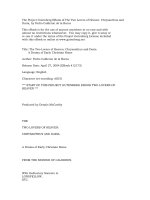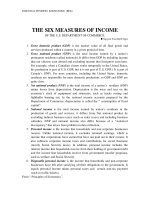the six measures of income.
Bạn đang xem bản rút gọn của tài liệu. Xem và tải ngay bản đầy đủ của tài liệu tại đây (31.41 KB, 2 trang )
ESSENTIAL BUSINESS KNOWLEDGE (BEK)
THE SIX MEASURES OF INCOME
OF THE U.S. DEPARTMENT OF COMMERCE.
Nguyen Tran Bich Ngoc
1. Gross domestic product (GDP) is the market value of all final goods and services
produced within a country in a given period of time.
2. Gross national product (GNP) is the total income earned by a nation’s
permanent residents (called nationals). It differ from GDP by including income
that our citizens earn abroad and excluding income that foreigners earn here. For
example, when a Canadian citizen works temporally in the United States, his
production is part of U.S. GDP, but it is not part of U.S. GNP.( It is part of
Canada’s GNP). For most countries, including the United States, domestic
residents are responsible for most domestic production, so GDP and GNP are
quite close.
3. Net national product (NNP) is the total income of a nation’s resident (GNP)
minus losses from depreciation. Depreciation is the wear and tear on the
economy’s stock of equipment and structures, such as trucks rusting and
lightbulbs burning out. In the national income accounts prepared by the
Department of Commerce, depreciation is called the “ consumption of fixed
capital”.
4. National income is the total income earned by nation’s residents in the
production of goods and services, it differs from Net national product by
excluding indirect business taxes (such as sales taxes) and including business
subsidies. NNP and national income also differ because of a “statistical
discrepancy” that arises from problem in data collection.
5. Personal income is the income that households and non-corporate businesses
receive. Unlike national income, it excludes retained earnings, which is income
that corporations have earned but have not paid out to their owners. It also
subtracts corporate income taxes and contributions for social insurance (mostly
Social Security taxes). In addition, personal income includes the interest income
that households receive from their holding of government debt and the income
that households receive from government transfer programs, such as welfare and
Social Security.
6. Disposable personal income is the income that households and non-corporate
businesses have left after satisfying all their obligations to the government. It
equals personal income minus personal taxes and certain non-tax payment (such
as traffic tickets).
From “ Principles of Economics”.
ESSENTIAL BUSINESS KNOWLEDGE (BEK)









